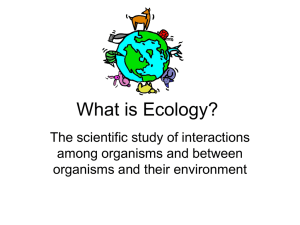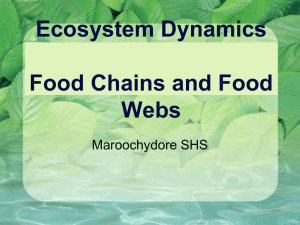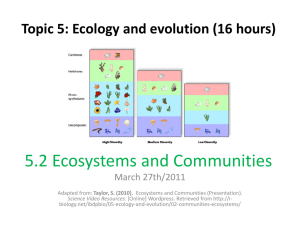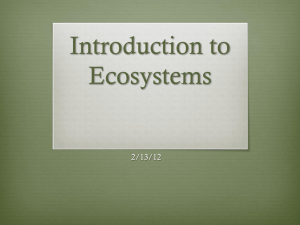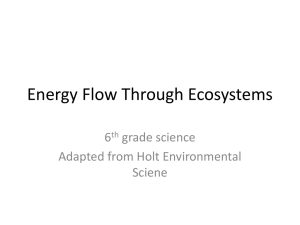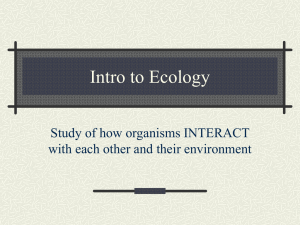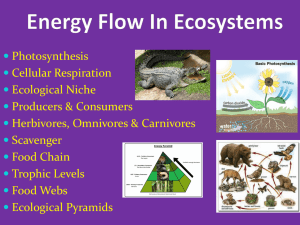Chapter 5 How Ecosystems Work Section 1: Energy Flow in
advertisement
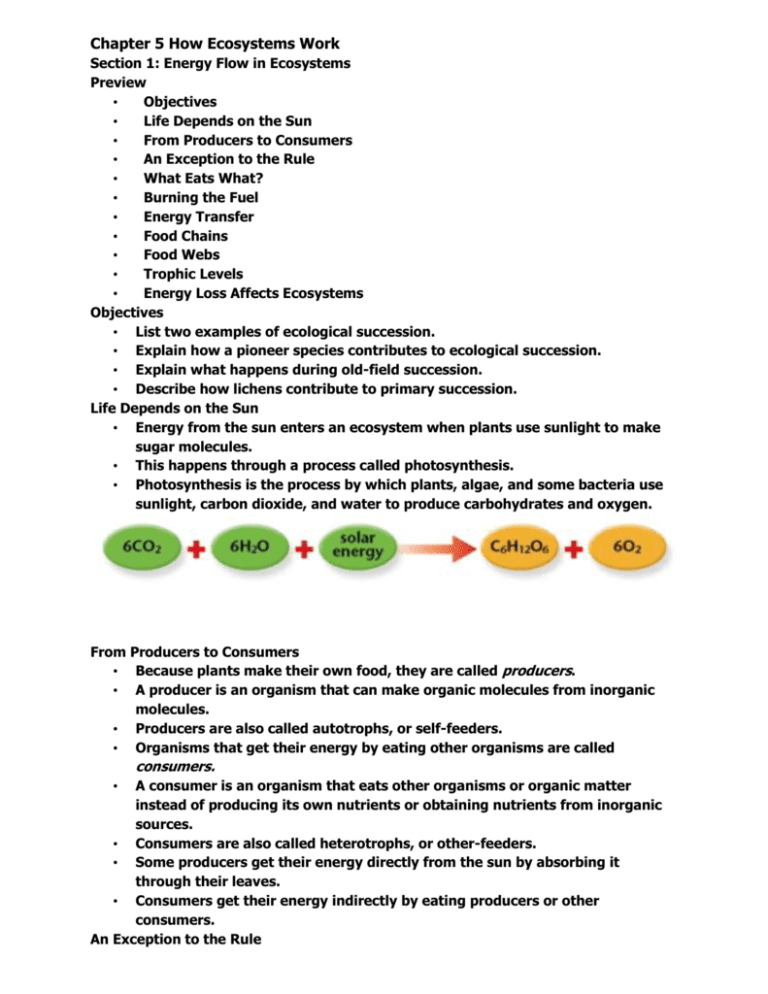
Chapter 5 How Ecosystems Work Section 1: Energy Flow in Ecosystems Preview • Objectives • Life Depends on the Sun • From Producers to Consumers • An Exception to the Rule • What Eats What? • Burning the Fuel • Energy Transfer • Food Chains • Food Webs • Trophic Levels • Energy Loss Affects Ecosystems Objectives • List two examples of ecological succession. • Explain how a pioneer species contributes to ecological succession. • Explain what happens during old-field succession. • Describe how lichens contribute to primary succession. Life Depends on the Sun • Energy from the sun enters an ecosystem when plants use sunlight to make sugar molecules. • This happens through a process called photosynthesis. • Photosynthesis is the process by which plants, algae, and some bacteria use sunlight, carbon dioxide, and water to produce carbohydrates and oxygen. From Producers to Consumers • Because plants make their own food, they are called producers. • A producer is an organism that can make organic molecules from inorganic molecules. • Producers are also called autotrophs, or self-feeders. • Organisms that get their energy by eating other organisms are called consumers. A consumer is an organism that eats other organisms or organic matter instead of producing its own nutrients or obtaining nutrients from inorganic sources. • Consumers are also called heterotrophs, or other-feeders. • Some producers get their energy directly from the sun by absorbing it through their leaves. • Consumers get their energy indirectly by eating producers or other consumers. An Exception to the Rule • Deep-ocean communities of worms, clams, crabs, mussels, and barnacles, exist in total darkness on the ocean floor, where photosynthesis cannot occur. • The producers in this environment are bacteria that use hydrogen sulfide present in the water. • Other underwater organisms eat the bacteria or the organisms that eat the bacteria. What Eats What? • Organisms can be classified by what they eat. • Types of Consumers: • Herbivores • Carnivores • Omnivores • Decomposers • Burning the Fuel • An organism obtains energy from the food it eats. • This food must be broken down within its body. • The process of breaking down food to yield energy is called cellular respiration. • Cellular Respiration is the process by which cells produce energy from carbohydrates; atmospheric oxygen combines with glucose to form water and carbon dioxide. • Cellular respiration occurs inside the cells of most organisms. • During cellular respiration, cells absorb oxygen and use it to release energy from food. • Through cellular respiration, cells use glucose (sugar) and oxygen to produce carbon dioxide, water, and energy. Part of the energy obtained through cellular respiration is used to carry out daily activities. • Excess energy is stored as fat or sugar. Energy Transfer • Each time an organism eats another organism, an energy transfer occurs. • This transfer of energy can be traced by studying food chains, food webs, and trophic levels. Food Chains • A food chain is a sequence in which energy is transferred from one organism to the next as each organism eats another organism. • Food Webs • Ecosystems, however, almost always contain more than one food chain. • A food web shows many feeding relationships that are possible in an ecosystem. Trophic Levels • Each step in the transfer of energy through a food chain or food web is known as a trophic level. • A trophic level is one of the steps in a food chain or food pyramid; examples include producers and primary, secondary, and tertiary consumers. • Each time energy is transferred, some of the energy is lost as heat. • • Therefore, less energy is available to organisms at higher trophic levels. One way to visualize this is with an energy pyramid. Trophic Levels cont. • Each layer of the pyramid represents one trophic level. • Producers form the base of the energy pyramid, and therefore contain the most energy. • The pyramid becomes smaller toward the top, where less energy is available. Energy Loss Affects Ecosystems • Decreasing amounts of energy at each trophic level affects the organization of an ecosystem. • Energy loss affects the number of organisms at each level. • Energy loss limits the number of trophic levels in an ecosystem.

